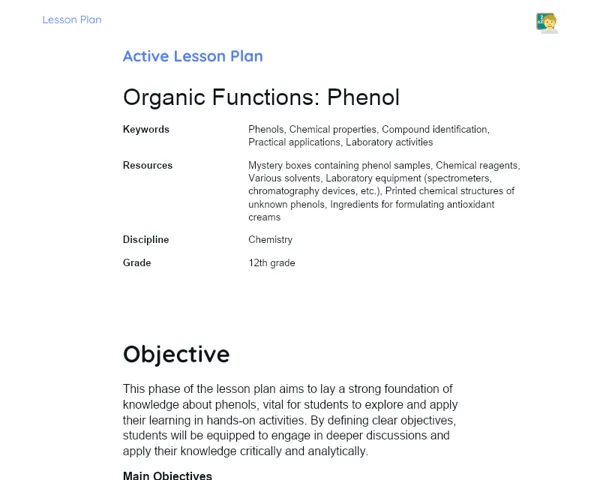Lesson Plan Teknis | Organic Functions: Amide Nomenclature
| Palavras Chave | Amides, IUPAC Nomenclature, Nomenclature of organic compounds, Pharmaceutical industry, Synthetic materials, Molecular models, Organic chemistry, Practical construction, Experimental skills, Scientific communication |
| Materiais Necessários | Short video on the application of amides, Molecular model kits, Recyclable materials (toothpicks, modelling clay), List of amides (methanamide, ethanamide, propanamide), Whiteboard and markers, Computer and projector, Supporting materials on IUPAC nomenclature |
Objective
Duration: 10 to 15 minutes
The aim of this section of the lesson plan is to ensure that learners grasp the significance and practical application of amide nomenclature. By honing their practical and experimental skills, learners will be better equipped for real-world scenarios, whether in academia or industry, where accurate nomenclature of organic compounds is critical.
Objective Utama:
1. Identify and correctly use the IUPAC nomenclature for amides.
2. Distinguish the nomenclature of amides from that of other organic compounds.
Objective Sampingan:
- Enhance practical skills in recognising and naming amides.
- Employ acquired knowledge in practical scenarios and the job market.
Introduction
Duration: 10 to 15 minutes
The aim of this section of the lesson plan is to ensure that learners understand the significance and practical application of amide nomenclature. By enhancing their practical skills, learners will be more prepared for real-world contexts where precision in nomenclature is vital.
Curiosities and Market Connection
Amides are crucial in the pharmaceutical sector, acting as key components in medicines like paracetamol. They are also significant in creating robust polymers such as nylon, frequently used in clothing and industrial tools. Mastering amide nomenclature enables chemistry and engineering professionals to innovate new materials and medications more effectively.
Contextualization
Amides are organic compounds that are commonly found in various sectors, including pharmaceuticals and synthetic material production. Grasping the nomenclature of amides is not just a theoretical exercise; it’s a vital practical skill that can be applied in chemistry labs, the pharmaceutical industry, and scientific research. Precision in nomenclature is essential for the accurate identification and application of these compounds.
Initial Activity
Kick off the lesson with a short video (2-3 minutes) that showcases the use of amides in producing medicines and industrial materials. After watching, pose this intriguing question to the students: 'How might precise nomenclature of organic compounds influence the development of new medications?'
Development
Duration: 55 to 65 minutes
The aim of this section of the lesson plan is to deepen learners' comprehension of amide nomenclature through hands-on activities and reflection. By constructing molecular models, learners will better understand the structures of amides and nomenclature rules, while also developing collaborative and communication skills.
Topics
1. Definition of amides
2. Molecular structure of amides
3. IUPAC nomenclature rules for amides
4. Differences between amides and other organic compounds
Thoughts on the Subject
Encourage a discussion on why precision in amide nomenclature is important for developing new materials and medications. Ask learners how accurately understanding nomenclature could influence scientific and industrial research, sharing examples from the pharma and synthetic materials fields.
Mini Challenge
Constructing Molecular Models of Amides
Learners will build molecular models of different amides using model kits or recyclable materials to gain a better grasp of the structures and nomenclature of these compounds.
1. Divide the class into groups of 3-4 learners.
2. Provide each group with molecular model kits or recyclable materials (like toothpicks and modelling clay).
3. Present a list of amides (e.g., methanamide, ethanamide, propanamide) for each group to select one to create.
4. Guide the groups to build the molecular model of the selected amide, adhering to IUPAC nomenclature rules.
5. Request that each group write down the structural formula and IUPAC name of the constructed amide, explaining their naming process.
6. Once models are built, have each group present their model to the class, emphasising the nomenclature and structure of the amide.
Build practical skills in constructing molecular models and reinforce understanding of IUPAC nomenclature rules for amides.
**Duration: 30 to 35 minutes
Evaluation Exercises
1. List three amides and provide their correct IUPAC names.
2. Differentiate the nomenclature of amides from other organic functional groups like carboxylic acids and amines, giving examples.
3. Explain, with examples, how IUPAC nomenclature can eliminate ambiguities in scientific communication.
Conclusion
Duration: 10 to 15 minutes
The purpose of this section of the lesson plan is to cement acquired knowledge by linking theory and practice while promoting reflection on the topic's application in the real world. This closure aims to ensure learners appreciate the topic's relevance to their academic journeys and future career opportunities.
Discussion
Lead a discussion among learners about how precision in amide nomenclature affects the development of new materials and medications. Ask how the practical activity enhanced their understanding of IUPAC rules and encourage sharing of real-world applications, particularly in the pharmaceutical and synthetic materials sectors.
Summary
Summarise the key topics covered, such as defining amides, their molecular structure, IUPAC nomenclature rules, and differences between amides and other organic compounds. Stress the importance of precision in nomenclature and its role in facilitating scientific communication and product development.
Closing
Convey that understanding amide nomenclature is vital not only for academic assessments but also for professional practice across various fields like industrial chemistry and scientific research. Highlight how the knowledge gained today can serve as a powerful asset in the job market, particularly in the development of new medications and materials.



